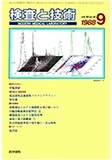Japanese
English
- 有料閲覧
- Abstract 文献概要
先輩技師:私は学校でタイプを習ったことがありません.タイプをするときは,いつも見よう見まねです.日本語の原稿の場合,2マス目から書き始めます.同じパラグラフ内では文章と文章の間はマス空けしませんし,句読点はすべて1マスずつとります.英文タイプの場合はどうですか?
英文編集者:日本語の場合とずいぶん違います.まず第一に,パラグラフの書き出しは少なくとも4字分空けます.同じパラグラフ内では文章と文章の間は1字分でなく,2字分空けます.普通,ピリオド,コンマ,セミコロン,コロンのような句読点の前はスペースを空けません.コンマの後は1字分空け,セミコロンとコロンの後,そして文末のピリオドの後は2字分空けます.これらスペースの空けかたについでの規則をリストにして,タイプライターにセロテープで貼りつけておくといいですよ.行の終わりで単語を切らなけれはならないときの切りかたを知っていますか?
Senior technologist : I have never learned typing in school. When I type, I always follow someone's example. In Japanese manuscripts, we write the first character in the second box. There is no space between sentences in the same paragraph,① and all kinds of punctuation need their own box. How about when you type?
English editor : It's very different from Japanese. First of all, to begin a new paragraph, you should indent at least four spaces. Between sentences in the same paragraph, there should be two spaces, not one. Usually there's no space before punctuation : a period, comma, semicolon, or colon. There's one space after a comma, and two spaces after a semicolon, a colon, or a period ending a sentence. English for Medical TechnologistsI recommend that you tape to your typewriter a list of these rules about spacing. Do you know how to divide words at the end of a line?
Copyright © 1988, Igaku-Shoin Ltd. All rights reserved.


